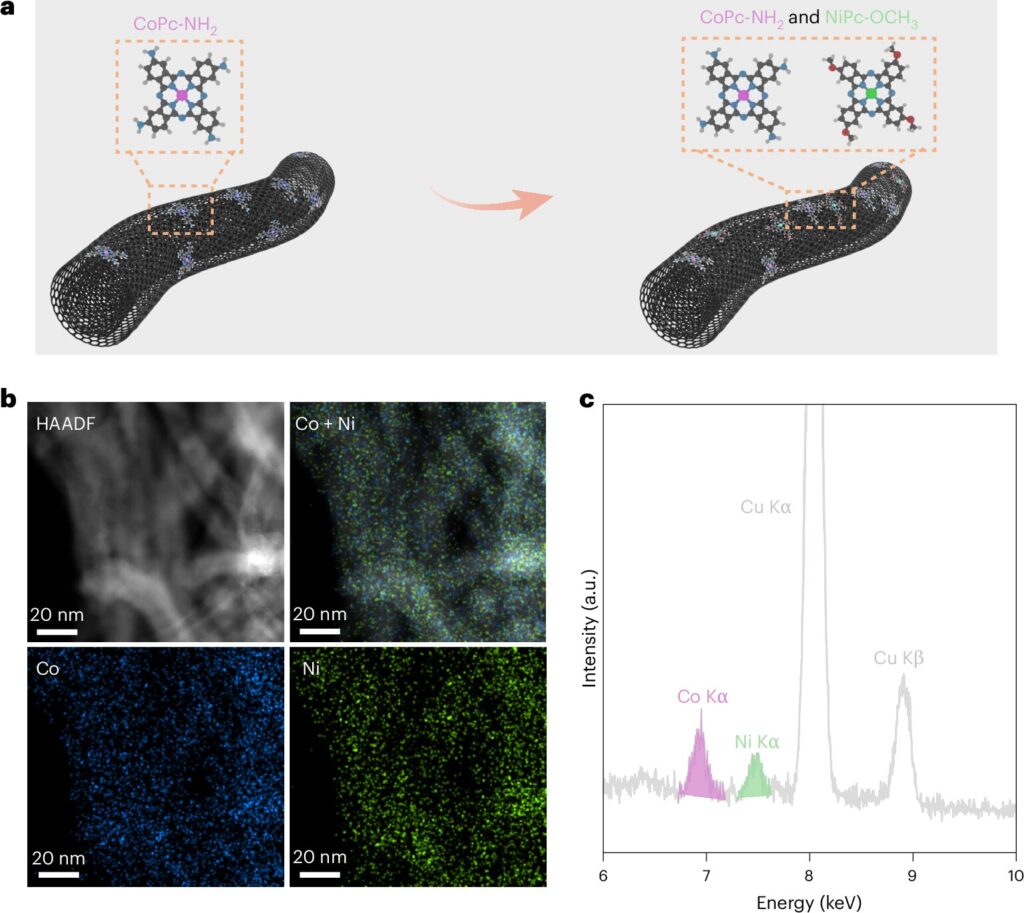Methanol, important for the manufacture of many everyday goods and for its green energy potential, may soon be produced faster and more efficiently thanks to a collaboration that included two Oregon State University researchers.
Zhenxing Feng and Alvin Chang of the OSU College of Engineering helped characterize a novel electrocatalyst developed by collaborators at Yale University and helped explain the improved efficiency for deriving methanol from carbon dioxide, a greenhouse gas that’s largely responsible for global climate change.
Findings of the study were published today in Nature Nanotechnology.
The researchers’ dual-site catalyst is the result of combining two different catalytic sites at adjacent locations, separated by about 2 nanometers, on carbon nanotubes and represents a significant improvement over previous single-site catalysts.
The new design increases the methanol production rate and results in a higher Faradaic efficiency of 50%, meaning less of the electricity used to catalyze the reaction is wasted. The previous single-site version operated at less than 30%.
“Methanol is a flexible chemical feedstock that is used for hundreds of common products including plastics, chemicals and solvents,” said Chang, a doctoral student at OSU. “It’s also a promising green fuel that can be produced from harmful carbon emissions using renewable electrical energy via a process called electrochemical CO2 reduction, simultaneously helping with environmental challenges and energy demands.”
Methanol, also known as wood alcohol, is a comparatively clean-burning compound that can be used in fuel cells, as an alternative to gasoline in internal combustion engines, and as fuel for ships and electricity generation.
In addition to carbon dioxide, which is released into the atmosphere primarily through the burning of fossil fuels, methanol can be produced from sources such as agricultural and municipal waste—meaning it has potential for helping to reduce greenhouse gas emissions and supporting a transition to more eco-friendly energy sources, the researchers note.
A catalyst is anything that speeds the rate of a chemical reaction without being consumed by the reaction, and an electrocatalyst is a material that hastens an electrochemical reaction by lowering its activation energy.
Cobalt phthalocyanine molecules supported on carbon nanotubes are one of the very few molecules that can catalyze the electrochemical reduction of carbon dioxide into methanol, said Feng, an associate professor at OSU. A drawback of the previous generation of this catalyst, which contains cobalt tetraaminophthalocyanine molecules as the only active sites, is its relatively low selectivity for methanol.
The electrochemical carbon dioxide reduction reaction happens in two parts, Chang said. Carbon dioxide is first converted to carbon monoxide, which is then converted to methanol.
“The single-site catalyst is limited by a tradeoff,” he said. “At the optimal potential for catalyzing the carbon monoxide to methanol step, it is not efficient in turning carbon dioxide to carbon monoxide.”
The research team introduced nickel tetramethoxyphtyalocyanine into the system and found it can help catalyze the carbon dioxide to carbon monoxide step, resulting in improved methanol production.
“The hybrid catalyst was found to exhibit unprecedented high catalytic efficiencies, nearly 1.5 times higher than observed before,” Feng said. “Advanced vibrational and X-ray spectroscopy revealed that the improvement is because of a carbon monoxide transfer from a nickel site to a cobalt site on the same carbon nanotube.”
Hailiang Wang of Yale University led the study, which also included researchers from The Ohio State University and the Southern University of Science and Technology in Shenzhen, China.


